Words such as these were emblazoned in dozens of languages on the front page of newspapers around the world, echoing the first part of President John F. Kennedy’s bold challenge to the nation, made more than eight years earlier – to land a man on the Moon. That part was successfully accomplished on July 20, 1969. The second part of the challenge, the safe return to Earth, would have to wait four more days.
Apollo 11 astronauts Neil A. Armstrong, Edwin E. “Buzz” Aldrin, and Michael Collins awoke to start their fifth day in space at the end of their ninth revolution around the Moon. In Mission Control at the Manned Spacecraft Center, now the Johnson Space Center in Houston, Eugene F. Kranz’s White Team of controllers arrived on console, with astronaut Charles M. Duke serving as Capcom. After a quick breakfast, Aldrin and Armstrong began re-activating the Lunar Module (LM) Eagle, including deploying its landing gear, and donned their pressure suits. Near the end of the 12th orbit around the Moon, Duke radioed up to Apollo 11 that they were GO to undock. The event took place behind the Moon during the start of their 13th revolution, the astronauts filming each other’s spacecraft as they began their independent flights (clip 1, clip 2). After they reappeared from behind the Moon, Armstrong radioed their status to MCC saying, “The Eagle has wings.” Collins in the Command Module (CM) Columbia observed, “I think you’ve got a fine looking flying machine there, Eagle, despite the fact you’re upside down,” prompting Armstrong to reply, “Somebody’s upside down.”

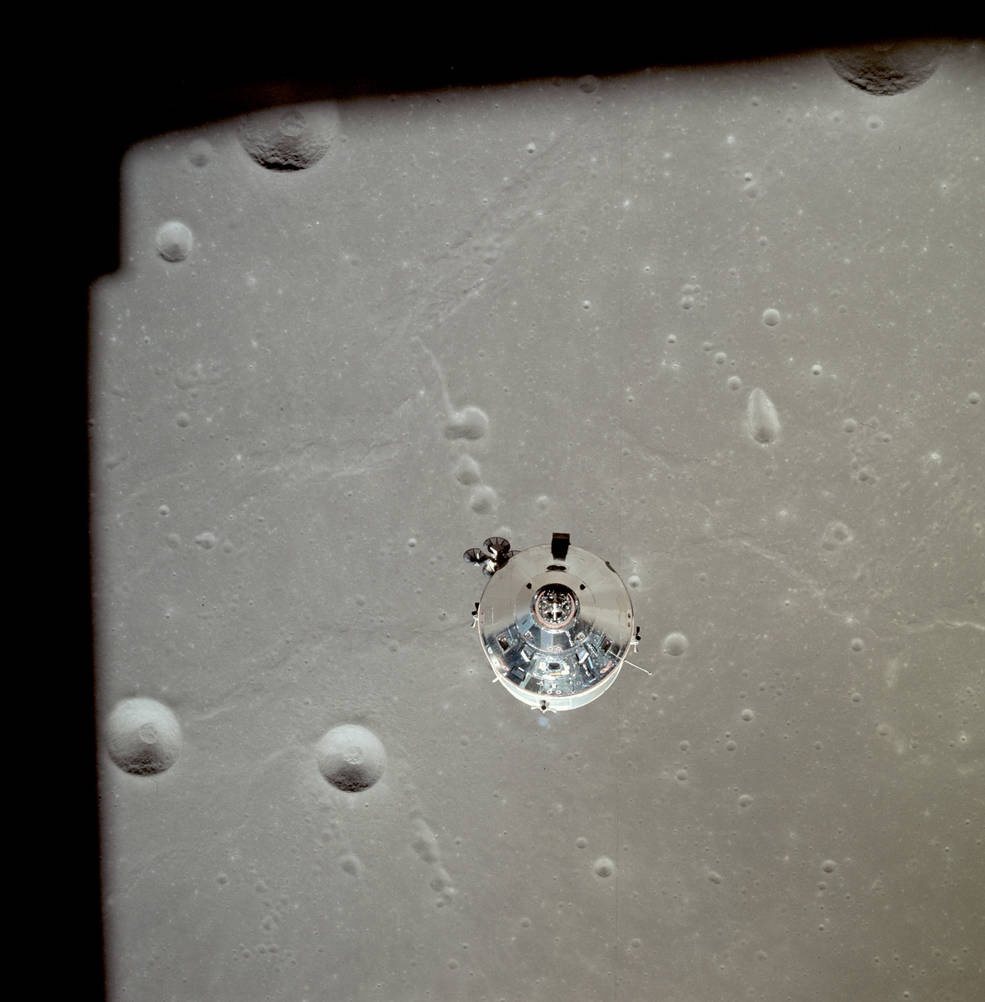
Left: Eagle shortly after undocking. Right: Columbia shortly after undocking.
From this point on, it was time to get down to business as events happened rather quickly. As the Moon landing attempt was less than an hour away, the viewing gallery in Mission Control was filling with NASA managers from across the agency, and many astronauts were present in the control room itself to witness the historic event. Later during the 13th orbit, about 10 minutes before Apollo 11 disappeared again behind the Moon, Duke radioed up the GO for Descent Orbit Insertion (DOI). The DOI burn, a 30-second firing of the LM’s Descent Propulsion System (DPS) engine took place behind the Moon, lowering the low point of Eagle’s orbit to about 50,000 feet, as close as Apollo 10 got to the Moon’s surface. The two craft now flying separately reappeared from behind the Moon on their 14th orbit. Duke radioed up the GO for Powered Descent Initiation (PDI), the beginning of the landing maneuver. Eagle’s antenna repeatedly lost lock on the Earth so Mission Control had to communicate with Eagle through Collins in Columbia until reliable radio links were re-established.
At the beginning of PDI, the LM’s DPS engine ran at 10% thrust for 26 seconds for a smooth initial deceleration before increasing to full thrust. Eagle was flying engine first and windows facing down toward the Moon’s surface and was about 300 miles east of the landing site in the Sea of Tranquility. Eagle’s attitude allowed Armstrong to track landmarks as they passed over them against the predicted times. Based on Eagle passing landmarks about two to three seconds early, Armstrong predicted that they would land about three miles further downrange than planned – and he was proved correct. At an altitude of 40,000 feet, Armstrong maneuvered Eagle to a windows up orientation. This was in preparation for the pitch-over maneuver, which placed the windows facing forward in the direction of flight, and also positioned the landing radar so it could see the lunar surface.
At about 33,000-foot altitude, Armstrong and Aldrin were surprised by the first 1202 program alarm, which they had not seen in simulations. After a few seconds of analysis in MCC, Duke gave them a GO to proceed. The alarm simply meant the computer was overloaded with too much data and couldn’t process it all, but controllers felt confident they could proceed with the landing. When a second 1202 alarm sounded less than a minute later Duke once again gave the GO to proceed. Eagle maneuvered to a more vertical orientation for the final phase of the descent. At about 5,000 feet and descending about 100 feet per second, Armstrong took over manual control of Eagle’s attitude. As they passed through 3,000 feet with their descent rate slowed to 70 feet/second, Duke gave them the GO for landing, and they received the 1201 program alarm. Once again, Duke gave them the GO to proceed. Another 1202 flashed at about 1,000 feet altitude. At about 600 feet, noticing Eagle’s computer was taking them down into a boulder-strewn area near West Crater, Armstrong took over manual control of the descent. He pitched Eagle to a more vertical orientation, which slowed the descent, and decided to overfly the rough area and look for smoother terrain to land on. Armstrong found and flew to a clearer spot for landing, and Aldrin called out that he saw the LM’s shadow on the Moon. Armstrong picked his final spot, about 60 meters east of Little West Crater. At about 100 feet, the fuel quantity warning light came on, indicating only 5% fuel remaining, giving Armstrong about 90 seconds of hover time left. With 60 seconds of fuel remaining, they were down to about 40 feet and the descent engine was kicking up dust from the surface, increasingly obscuring Armstrong’s visibility. At precisely 3:17:40 PM Houston time on July 20, 1969, Aldrin called out “Contact light,” indicating that at least one of the three 67-inch probes hanging from the bottom of three of the LM’s footpads had made contact with the Moon. Eagle drifted to the left when three seconds later, Armstrong called out, “Shutdown,” followed by Aldrin’s, “Okay. Engine stop,” indicating the DPS engine was shut off. They were on the Moon. In Houston, Duke noted via telemetry that the engine had shut down, and called to Armstrong and Aldrin, “We copy you down, Eagle.” Armstrong responded with the historic words, “Houston, Tranquility Base here. The Eagle has landed.”


Left: In Mission Control during the descent to the Moon (left to right) Capcom Duke, and Apollo 11 crewmembers James A. Lovell and Fred W. Haise. Right: In Mission Control during the Moon landing (left to right) Apollo 12 prime crewmembers Charles Conrad and Alan L. Bean and their backups David R. Scott and James B. Irwin.
It should be noted that for everyone on Earth, the first Moon landing was purely an audio experience. Controllers in MCC had the added benefit of telemetry from the spacecraft, but there was no live television of the landing. A 16-mm silent film camera mounted in the right hand (Aldrin’s) window recorded the event, but was not available for viewing until it was returned to Earth and developed. An annotated video of the landing was prepared from this film (courtesy of Apollo Flight Journal), and synchronized with space-to-ground communications, several loops in Mission Control, and video clips from MCC.
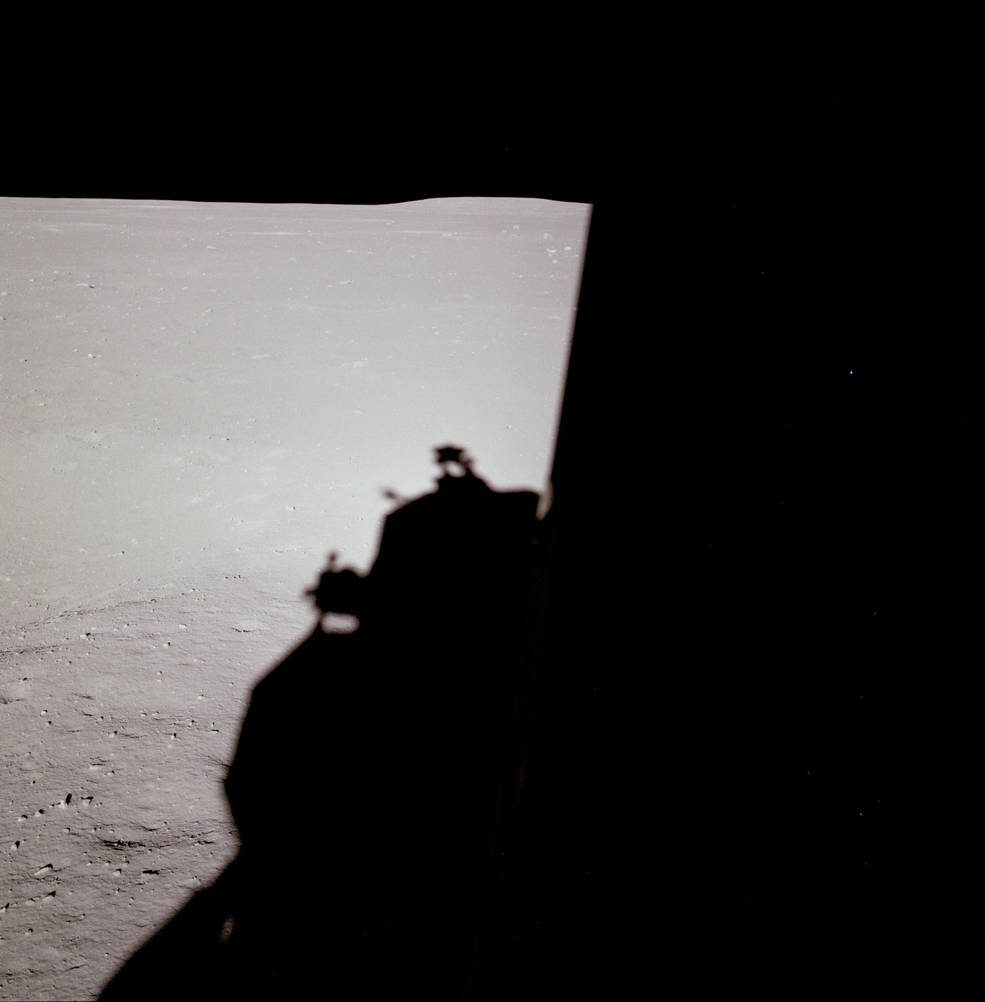
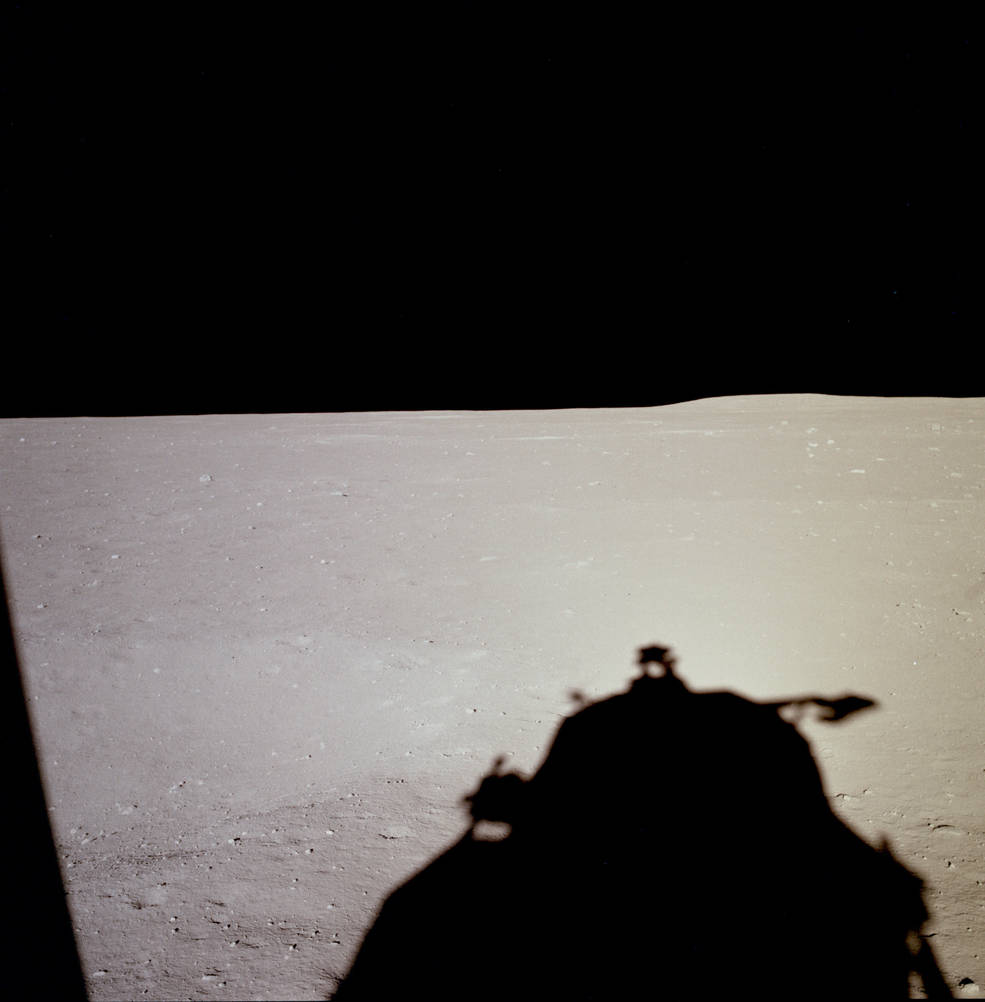

Three views of the lunar surface as Armstrong and Aldrin saw it shortly after landing, taken through Armstrong’s left side LM window (left), and through Aldrin’s right side window (middle and right).
After a few minutes, Aldrin provided the first verbal description of their surroundings, including the types and sizes of rocks and the general color of the surface. Duke radioed to them, “Be advised there’re lots of smiling faces in this room and all over the world,” prompting Armstrong’s response, “Well, there are two of them up here.” Armstrong reported that neither he nor Aldrin had any trouble adjusting to the one-sixth gravity on the lunar surface. He continued with a more detailed description of their view out the forward windows. As they continued their postlanding activities, Armstrong called MCC to advise that he and Aldrin would like to forego the planned rest period before their Extra-Vehicular Activity (EVA), or spacewalk, and MCC concurred with their proposal. Aldrin made the following request to anyone who might be listening, “I’d like to take this opportunity to ask every person listening in, whoever and wherever they may be, to pause for a moment and contemplate the events of the past few hours and to give thanks in his or her own way.” He then proceeded to take communion with a chalice and consecrated wine he brought along for the occasion. He and Armstrong then began preparations for their historic spacewalk, including donning their Portable Life Support Systems (PLSS), the backpacks that provided oxygen, removed carbon dioxide, and enabled communications. The Green Team of flight controllers led by Clifford E. Charlesworth, with Bruce McCandless serving as Capcom, took their positions in Mission Control to help Armstrong and Aldrin prepare for and execute their EVA. They reconfigured Eagle’s cabin for depressurization, donned their helmets, visors, and gloves, and then opened the valve that vented the cabin.
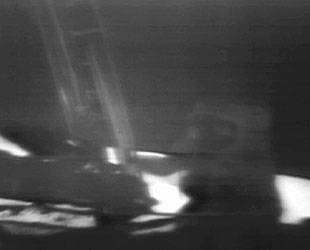

Two views of Armstrong taking the first step on the lunar surface. Left: Still image from
the live TV downlink. Right: Still image from the 16-mm camera mounted in Eagle’s window.
Aldrin opened Eagle’s forward hatch, which swung inward toward him, giving Armstrong access to the outside front porch. Aldrin added, “About ready to go down and get some Moon rock?” He helped Armstrong navigate through the narrow confines of Eagle’s hatch and onto the front porch. Once on the ladder, Armstrong pulled a lanyard that released the Modularized Equipment Stowage Assembly (MESA) on the side of Eagle’s Descent Stage, on which was mounted a black and white TV camera, allowing hundreds of millions of viewers on Earth to see him descend the ladder down to the landing leg’s footpad. As a precaution, he practiced the three-foot jump back up to the ladder’s first rung, made easier in the one-sixth lunar gravity. Once back down on the footpad, Armstrong described that the footpads had only sunk one or two inches into the lunar dust which he noted was fine-grained, almost powdery. Armstrong announced, “I’m going to step off the LM now.” And at 9:56 PM Houston time he did just that, firmly planting his left foot onto the lunar surface, proclaiming, “That’s one small step for a man, one giant leap for mankind.”


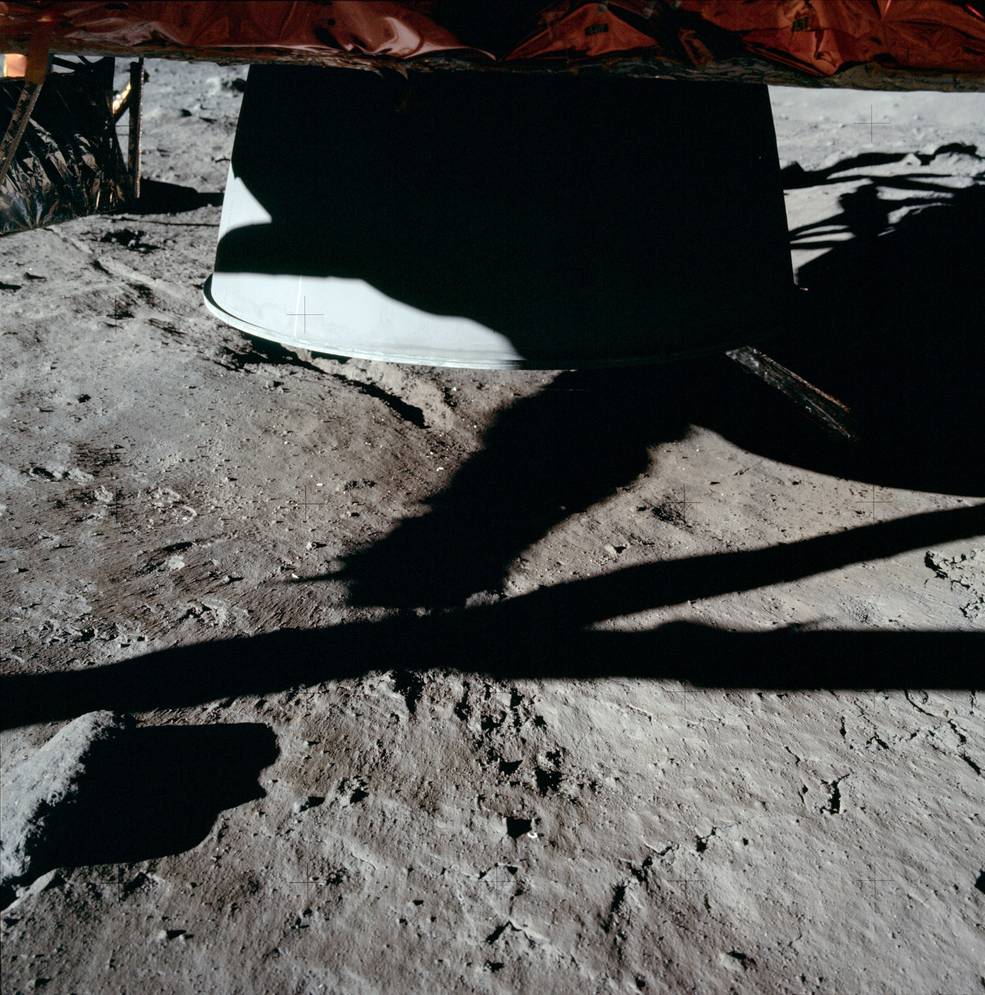
Left: First photograph from the surface EVA, showing a jettison bag and a gouge left in the lunar soil by the landing probe as Eagle drifted just before touchdown. Middle: Still from the 16-mm film of Armstrong collecting the contingency sample. Right: View of Eagle’s Descent Stage engine bell, also showing a gouge in the soil by another landing probe.
After taking his first tentative steps on the lunar surface, Armstrong began his first tasks of the spacewalk, including receiving the Hasselblad still camera from Aldrin via a lanyard and pulley system, using it to take the first photographs of Eagle to document how it fared during the landing as well as of their surroundings, and collecting the contingency sample of lunar material in case they had to make an emergency departure. A few minutes later, Aldrin began his descent to the surface, commenting on the way out of the cabin, “Now I want to … partially close the hatch. Making sure not to lock it on my way out.” This prompted a laugh from Armstrong who commented, “A particularly good thought.”

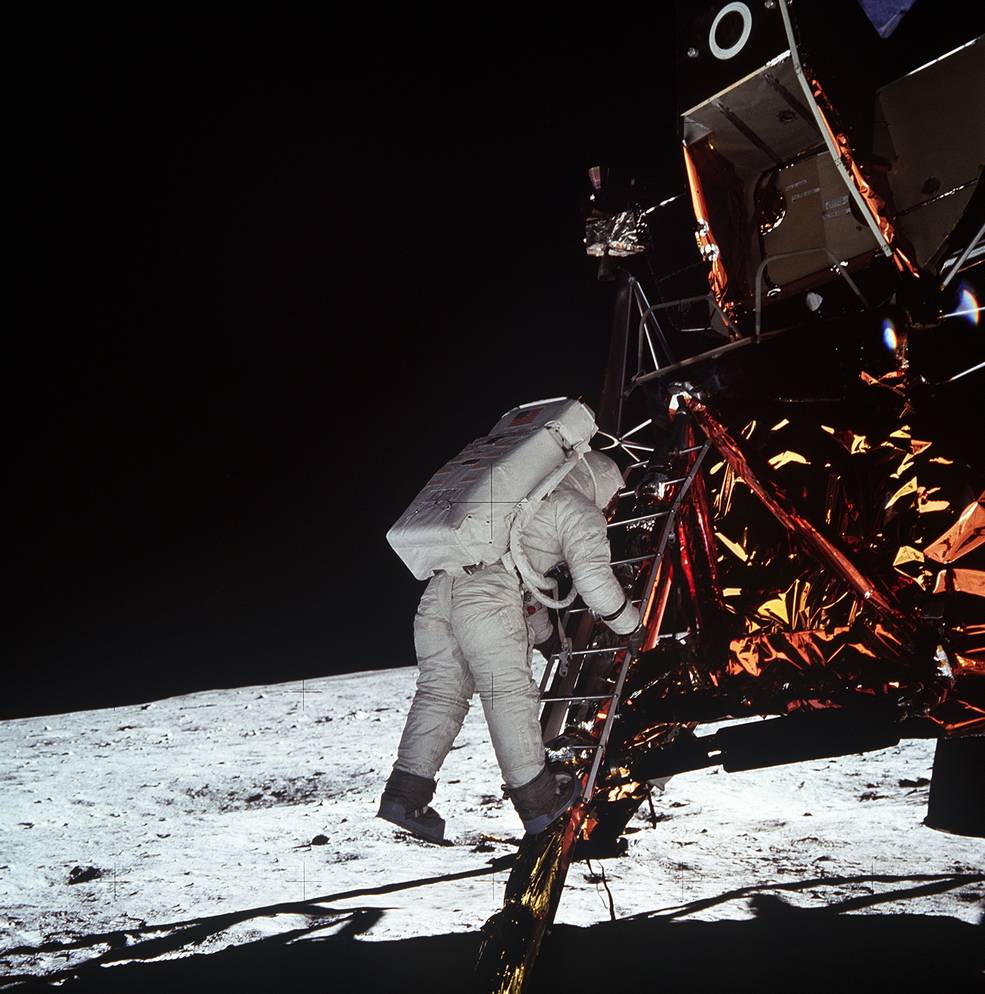

Sequence of images of Aldrin climbing down Eagle’s ladder to join Armstrong on the surface.
Once Aldrin was on the surface, he and Armstrong unveiled the commemorative plaque that was mounted on the landing leg and read the words that were inscribed on it, “Here men from the planet Earth first set foot upon the Moon, July 1969 A.D. We came in peace for all mankind.” The plaque bore the signatures of the Apollo 11 astronauts as well as of President Richard M. Nixon. Armstrong then removed the TV camera from the MESA, carried it about 60 feet from the LM, and mounted on a tripod so the world audience could watch their subsequent activities. Closer to the LM, Aldrin was setting up the Solar Wind Collector (SWC) experiment, a sheet of aluminum that was exposed to the Sun for 77 minutes to collect ions in the solar wind. Near the end of the EVA, Aldrin rolled up the foil and stowed it for return to Earth for analysis by scientists.


Left: Aldrin (left) and Armstrong reading the plaque mounted on Eagle’s forward landing leg strut. Right: Still from 16-mm film of Armstrong (left) and Aldrin setting up the American flag.
Their next task was to remove the Lunar Flag Assembly attached to Eagle’s ladder and set up the American flag about 20 feet from the LM. Because in the vacuum on the Moon there is no way for the flag to stay unfurled, a telescoping horizontal metal rod was inserted along the top of the 3-by-5-foot nylon flag. During the deployment, this metal rod did not extend all the way and left the edge of the flag somewhat wrinkled, giving it the appearance of waving in a non-existent lunar breeze. Aldrin began to experiment with different types of locomotion in the one-sixth gravity when Capcom McCandless requested that both astronauts position themselves in front of the TV camera. For the next two minutes, Armstrong and Aldrin talked to President Nixon in the White House’s Oval Office, who offered the nation’s congratulations on their historic accomplishment.



Three views of the same scene to provide spatial perspective on the astronauts’ activity. Left: A still from the live TV downlink that millions of viewers on Earth saw. Middle: Photograph of Aldrin and the US flag taken by Armstrong. Right: Still from the 16-mm film taken by the automatic camera installed inside the LM on Aldrin’s forward window.
The phone call concluded, Armstrong and Aldrin resumed their tasks, which included Aldrin performing soil cohesion tests by kicking the lunar surface with his boot and observing the resulting sprays of dust which in the vacuum and one-sixth gravity on the Moon behaved differently from how they would on Earth. Armstrong returned to the MESA to retrieve the equipment for the bulk sample collection of lunar material. Aldrin picked up the Hasselblad to take photographs for the Bootprint Penetration Experiment, and took panoramic photos of the landing site, incidentally taking one of the few photographs of Armstrong on the surface as he packs the bulk sample at the MESA.
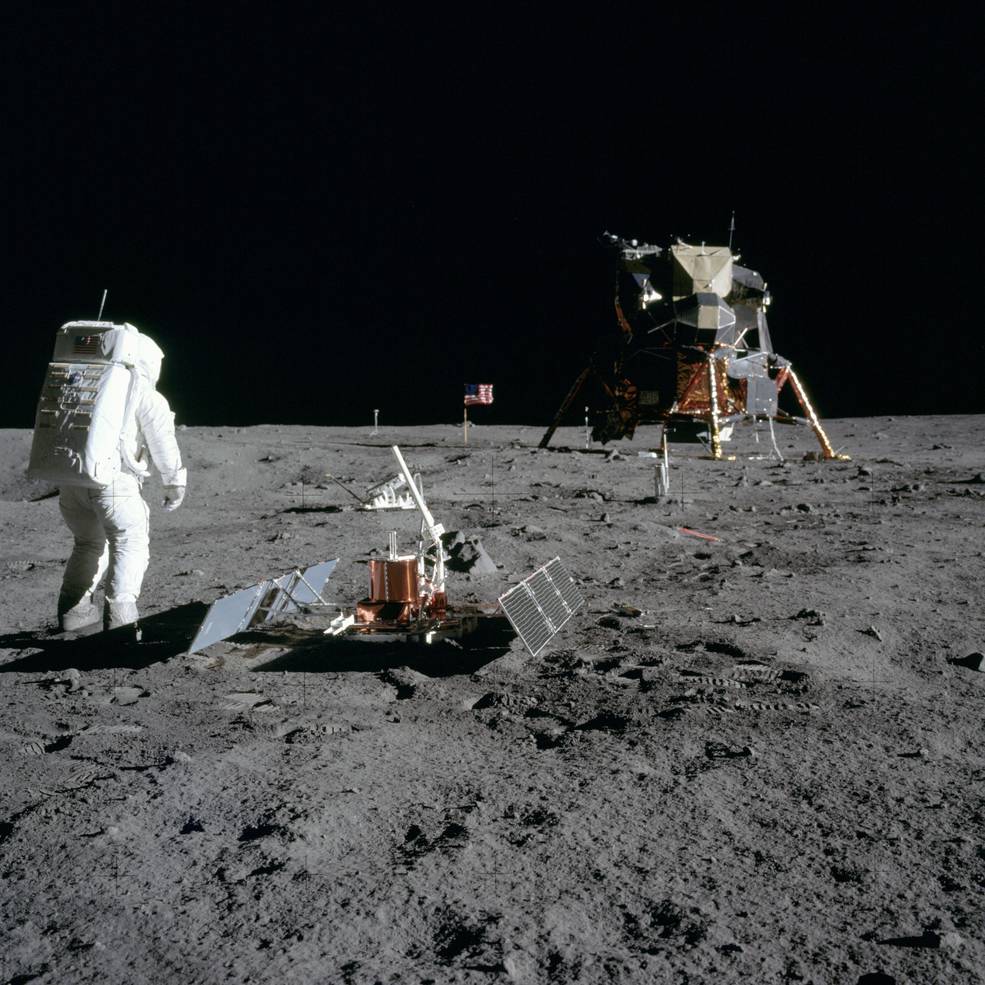
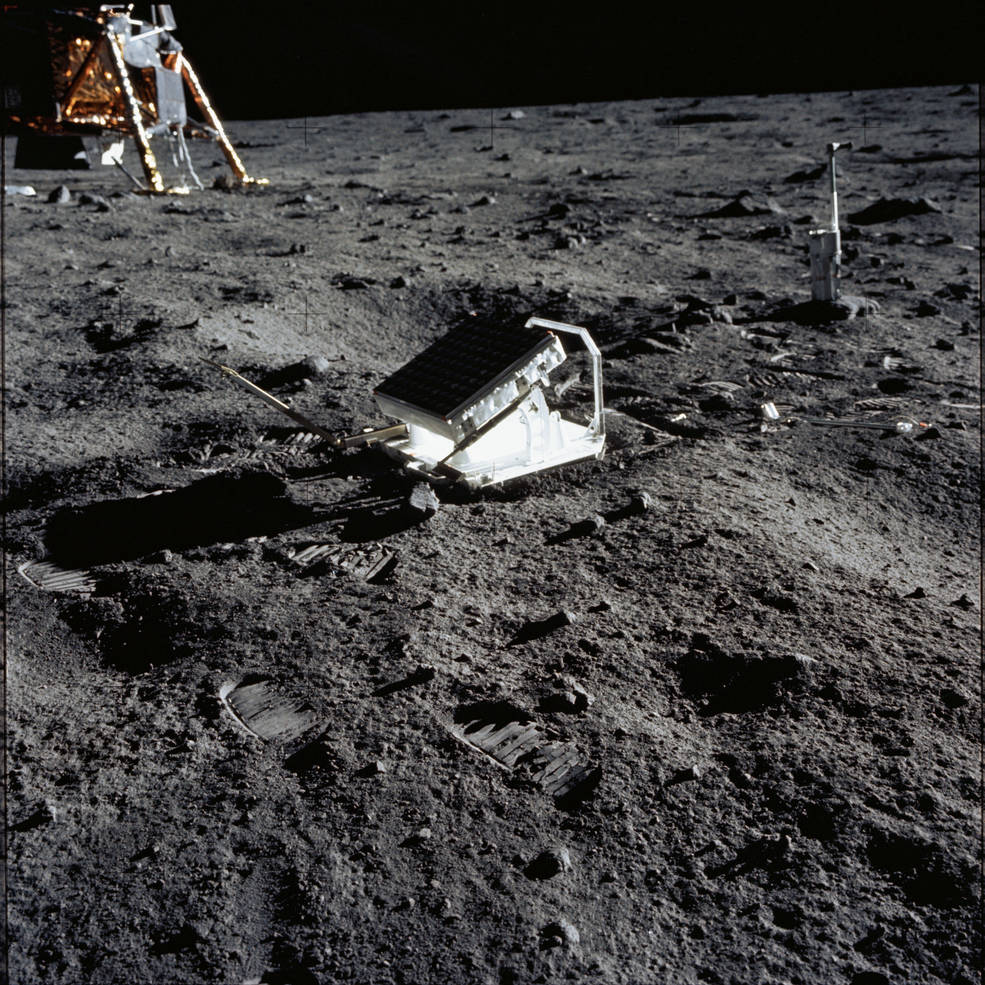
Left: Aldrin standing next to the seismometer.
Right: The Laser Ranging Retro-Reflector.
After more photography, Aldrin handed the camera back to Armstrong and walked to the back of the LM where the Scientific Equipment (SEQ) bay containing the Early Apollo Surface Experiment Package (EASEP) was located. The EASEP consisted of two experiments, the Passive Seismic Experiment Package (PSEP) to measure Moon quakes and the Laser Ranging Retro-Reflector (LRRR) that contained an array of mirrors to reflect a laser beam sent from Earth for precise measurements of the Earth-Moon distance. Aldrin removed the two experiments from the SEQ bay and carried them about 40 feet from the LM where he deployed the PSEP and Armstrong the LRRR. At this point, they were running about 30 minutes behind the timeline, but their consumables were within limits so McCandless called to tell them that Mission Control had given them a 15-minute extension on the EVA. He also mentioned that scientists had activated the seismometer and it was picking up the vibrations from their footsteps.


Left: One of the few still photographs of Armstrong on the lunar surface, packing
the bulk sample at the MESA; the American flag and the Solar Wind Collection
experiment can be seen in the left of the photograph. Right: Aldrin setting up the
Solar Wind Collection experiment.

Panoramic mosaic of several images taken by Armstrong at Little West Crater.
Aldrin returned to the MESA to begin getting two core samples as part of the documented samples. Armstrong jogged 180 feet to Little West Crater that they had overflown during the descent and took a series of panoramic shots before jogging back to the LM to assist Aldrin with the core samples. Finishing the core samples, Aldrin rolled up the solar wind experiment. Armstrong collected about 20 rock samples weighing about 13 pounds.
And with that, it was time to finish the EVA. Armstrong and Aldrin gathered the film magazines and closed up the rock boxes. Armstrong scooped up about 13 pounds of lunar dirt as packing material for the rocks in the boxes as Aldrin climbed up the ladder and back into the LM. From there he helped Armstrong transfer the rock boxes up to the cabin using the lanyard system. A film cassette attached to the first rock box fell off and into the lunar dirt, but Armstrong retrieved and reattached it. The dirt attached to the cassette would later cause an accidental exposure to one of the employees once in the Lunar Receiving Laboratory in Houston. They hauled the second rock box up to the cabin without incident.
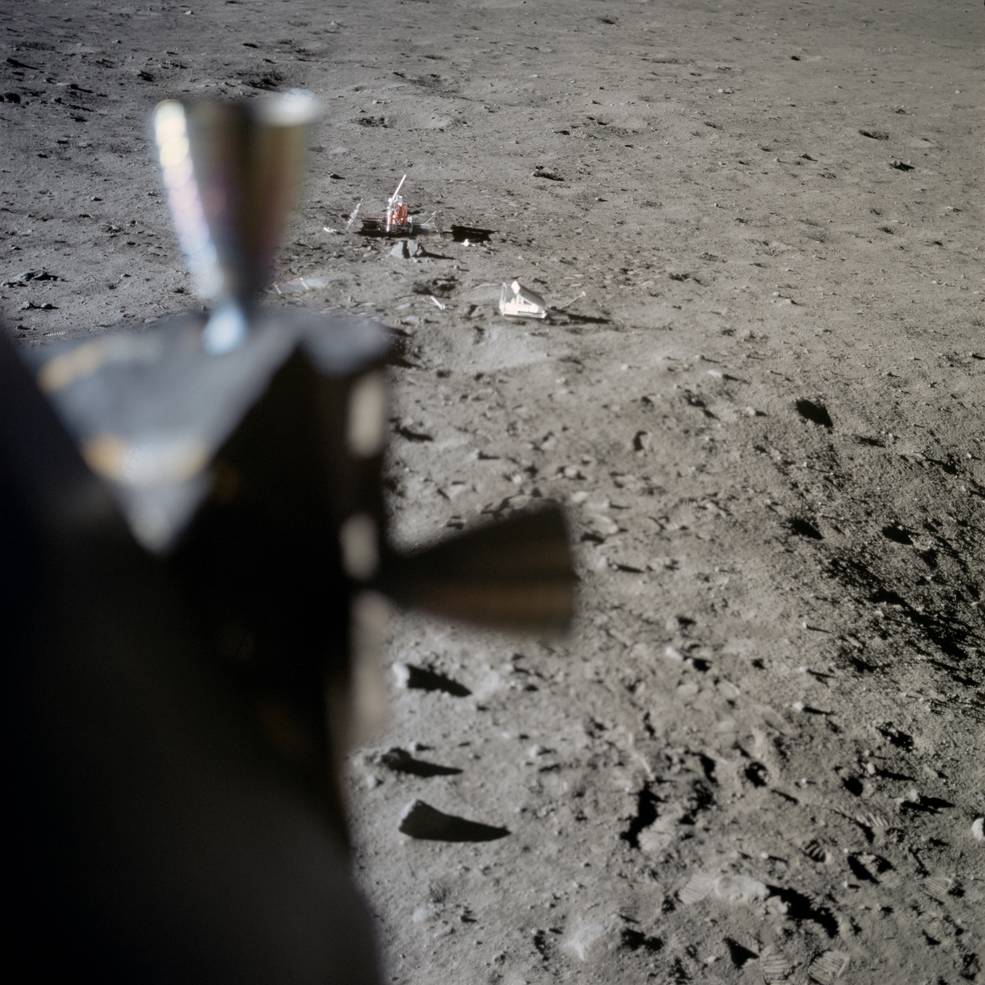


Photos taken after the EVA. Left: From Armstrong’s window, showing the two EASEP experiments. Middle: From Aldrin’s window, showing the flag and the TV camera. Right: The next morning, also from Aldrin’s window, showing that the flag had changed position due to settling in the lunar soil.
Just before Armstrong headed up the ladder, he reminded Aldrin about a small package of commemorative items that they wanted to leave on the surface. Aldrin tossed it down through the hatch from inside the cabin. The items included a silicon disc etched with goodwill greetings from 73 world leaders, an Apollo 1 patch commemorating astronauts Virgil I. Grissom, Edward H. White, and Roger B. Chaffee lost in the 1967 fire, two Soviet medals honoring cosmonauts Vladimir M. Komarov killed in the Soyuz 1 accident and Yuri A. Gagarin, the first man in space killed in an airplane crash in 1968, and a small gold olive branch, identical to ones the astronauts carried to the Moon and back for their wives. Armstrong then jumped up to the third rung of the ladder and climbed the rest of the way into the cabin. Within a minute they had the hatch closed and began repressurizing the LM. They removed their PLSS backpacks, took photographs out the windows to use up their remaining film, and ate a well-earned meal. Aldrin realized that probably while he was removing his PLSS, he broke the circuit breaker that armed the ascent stage engine, critical for their departure the next day. Fortunately, they were able to use a felt tip pen to depress the breaker button.
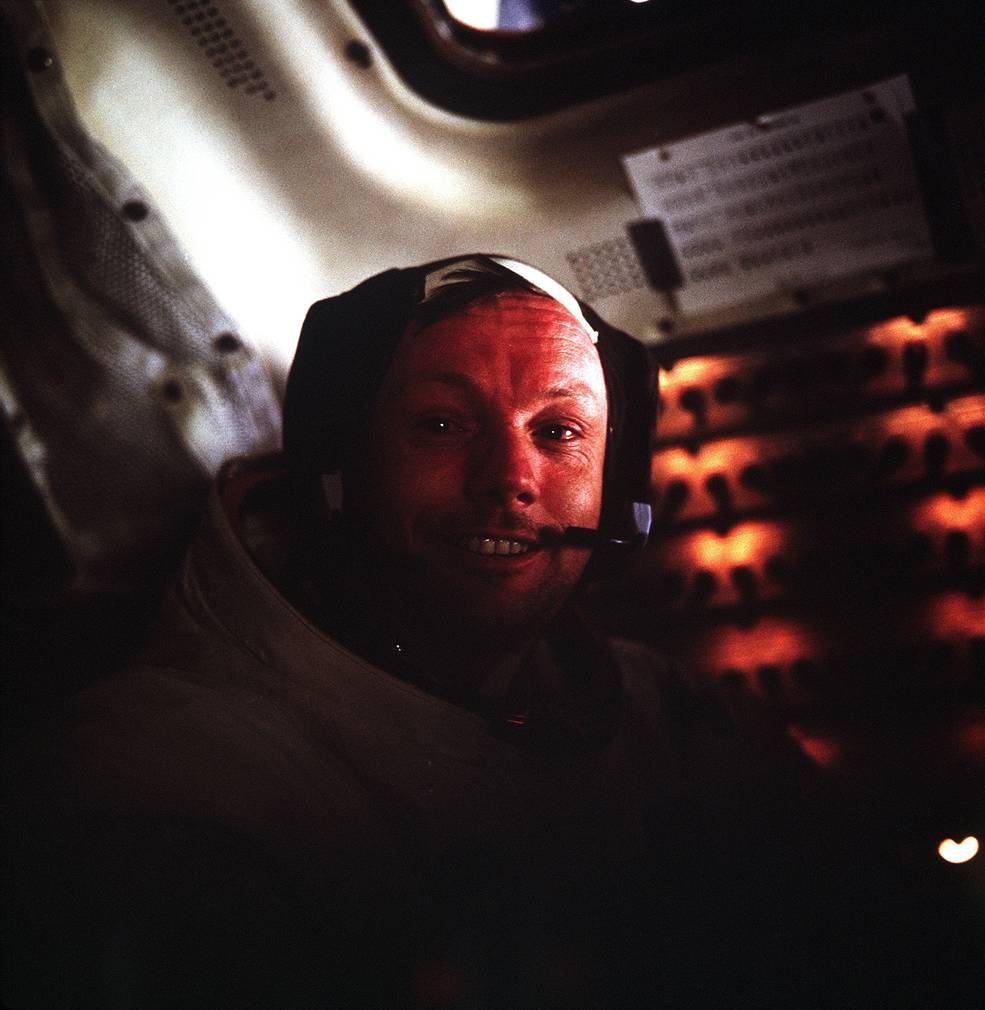

Armstrong (left) and Aldrin (right) back inside Eagle after the first spacewalk on the Moon.
Director of Flight Crew Operations Donald K. “Deke” Slayton called to the crew, “That’s a real great day, guys. I really enjoyed it.” Armstrong replied, “Thank you. You couldn’t have enjoyed it as much as we did,” and Aldrin, “It was great.” They then depressurized the LM cabin and threw their PLSS backpacks out the hatch along with a jettison bag containing their lunar boots and other items no longer necessary. This freed up space in the cramped cabin and reduced the weight of the LM at liftoff. Since the TV camera on the surface was still transmitting, MCC was able to observe the jettisons, and the PSEP recorded the items hitting the surface, prompting Armstrong to comment, “You can’t get away with anything anymore, can you?” They then repressurized the cabin for the final time. Their last duty before they turned in for a well-deserved albeit restless night’s sleep, having been awake for 21 hours, was to turn off the TV camera. Aldrin curled up on the floor of the LM while Armstrong devised a hammock and slept on the ascent stage engine cover. All was quiet on the Moon, but while the astronauts slept the American flag they planted shifted position as it settled in the loose lunar soil.





























